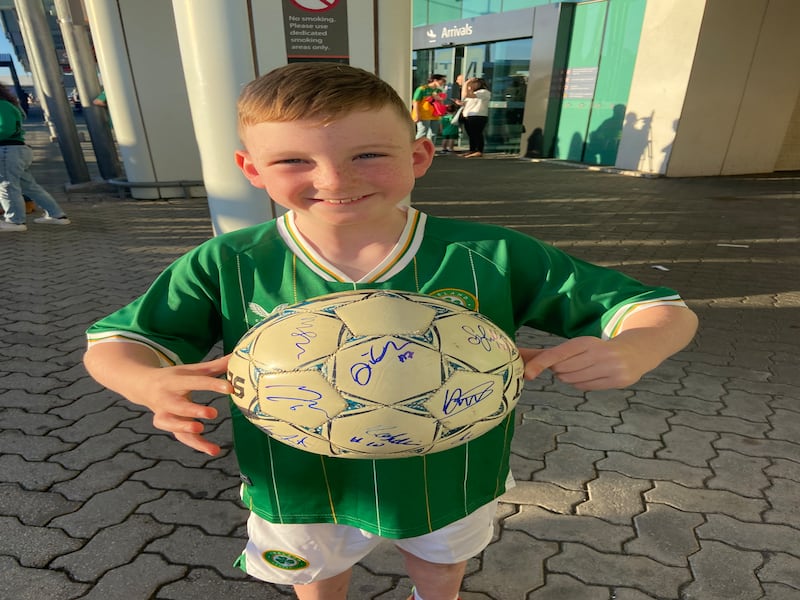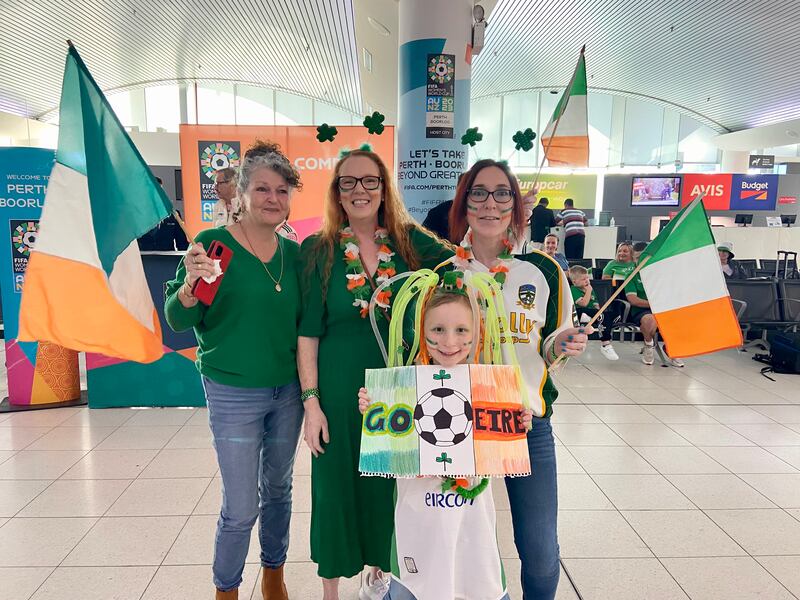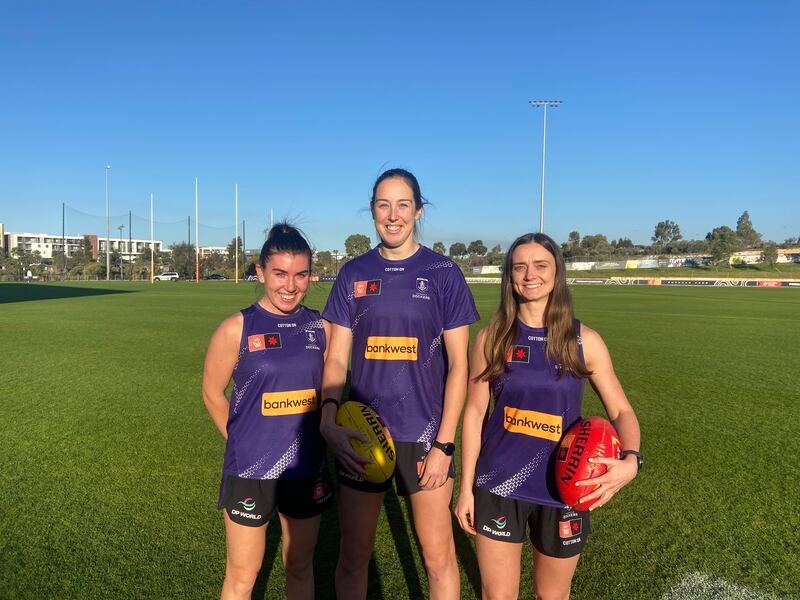The fans the Republic of Ireland team praised in Sydney as being the best in the world are in no short supply in Perth it seems.
Hundreds of people turned out with home-made banners to welcome the team at Perth airport ahead of their next crucial game against Canada in the Women’s World Cup. Many are expecting the atmosphere at the 20,000-capacity Perth Rectangular Stadium on Wednesday to feel like a home game for Ireland.
“I think the girls are going to be in shock with the amount of support there is. Once there’s an Irish event, people come from everywhere, we just turn up in our droves,” said Lorraine Hart, who has lived in Perth for 43 years but hasn’t yet picked up an Australian twang.
More than 2.1 million people live in the greater Perth area including 16,421 Irish-born migrants, according to 2021 census data.
READ MORE
In excess of 183,800 people in the greater Perth area claim Irish heritage, which widens the pool of potential Irish supporters for Wednesday’s match.
Also at the airport to welcome the girls in green were James and Lisa Boland, with their Australian-born children Danny and Effy, as well as Linda and Jason Bradley with their daughter Isla.
Isla, Danny and Effy, all cousins, had just returned from a trip to Ireland, where they visited Emerald Park and the Cliffs of Moher.
“They’re like tourists,” Mr Boland said.

James Boland owns a painting company and Lisa works for a scaffolding company, while Linda Bradley works in healthcare and Jason is an electrician.
“There’s so much more of a balance here, there’s no comparison I don’t think,” Ms Boland said, referring to the lifestyle.
Perth, dubbed the most isolated big city in the world, is the capital of the state of Western Australia (WA). The state government has schemes in place to lure tradespeople like Boland and Bradley to the remote state.
In February, the WA government launched a recruitment campaign in Ireland and the UK to fill almost 31,000 vacancies across the state.
Promising “higher wages, lower cost of living, and surf and sunshine lifestyle”, the mission targeted Irish teachers, police officers, nurses, midwives, doctors, dentists, mechanics, builders, plumbers, and those with experience in the mining and hospitality sectors.
“WA salaries are often more than 50 per cent higher than the average English salary for the same occupation,” a WA government spokesperson said at the time.
The campaign followed a 2022 visit to Ireland by former WA premier Mark McGowan, after years of closed borders during Covid, where he made the case for more Irish to move to WA.
Under the “Build a Life in WA” campaign, construction companies can apply for state funding to cover visa and relocation costs to bring international recruits to fill posts.
Healthcare workers are also targeted by recruiters and often come to WA in search of a better work-life balance.
Dr Ailbe Keane, originally from Galway, moved to Perth in August 2022. Keane graduated from UCD in 2021 and said about 80-90 per cent of her class came to Perth after their intern year.
“I wanted a good work-life balance after my intern year and to live somewhere beside the sea, with great weather and loads to do,” Keane said.

In the year 2021-2022, the vast majority of Irish doctors moving to Australia were choosing WA. In the period from July 2021 to June 2022, 269 out of 442 Irish doctors who were granted a temporary skilled work visa, chose to work in the state.
Between July 2022 and March 2023, 142 visas were also granted to Irish doctors to work in WA alone, while 156 were granted for the rest of Australia.
“The healthcare system in WA relies heavily on foreign national doctors, mostly Irish at the SHO [Senior House Officer] level but at all levels really because until one year ago, they only had one medical school for the whole region,” Keane said.
“It’s quite isolated from the rest of Australia so Australians from the east coast don’t typically want to come”.
At Keane’s level, Resident Medical Officer, she said there is protected teaching time, fixed start and finish times to her shifts and much less on-call work, compared to hospitals in Ireland.
“The work-life balance is more manageable and I think that also helps you enjoy the job more”.
Not all doctors who come out will stay, with some moving home to take up positions in training schemes. Keane said she plans to stay for at least another one to two years, unless an enticing training opportunity arises here.
Australian recruiters aren’t just looking for healthcare workers and trades people, they’re also setting their sights on Irish athletes.
Áine Tighe, a former county Gaelic football player with Leitrim, was contacted by a recruiter in Victoria who had seen videos of her playing.
She moved to Perth at the end of 2019. She’s now training for her fifth season with the Fremantle Dockers.
Women’s AFL in Australia is semi-professional. In reality, Tighe says that means players spend roughly 20 hours at the club per week. During the work week, that’s split between two evening sessions and a full day of training.
Outside of her commitments with Fremantle, she works in the club’s school programme. She had been a PE teacher at home.
Tighe and her three other Irish team-mates are four of 33 Irish women competing in the AFLW (Australian Football League Women’s Competition).

Amy Mulholland, who played for Armagh, and Joanne Cregg, who played for Roscommon, weren’t recruited from home.
Mulholland, an accountant, and Cregg, a doctor, came to Perth to work and had retired from GAA at home. They were both looking to pick up a new sport for fun.
But they soon found themselves winning amateur championships and getting drafted into semi-professional AFL.
Their workplaces have been supportive of them going to a four-day week during the playing season, which Mulholland says has given them a chance to concentrate on mastering a brand new sport.
The facilities they have access to at their Perth club compared to what they had at home are almost incomparable.
“We’ve gone from a position at home in the last couple of years where you’re fighting to get on to a pitch, or to get on to a decent pitch, to have changing rooms or a warm shower or the chance of a meal or expenses after training,” Cregg says. “We were fighting for those things at home but they’re a baseline here that you don’t even think about any more. I think that’s the biggest difference.”
It’s not only access to the $110 million stadium they train at in Cockburn, it’s also access to education and wellbeing programmes, recorded time coded training sessions they can watch back, recovery ice baths, players lounges, and much more, that Mulholland says helps them improve their performance.
“As a sportsperson, it’s kind of your dream position to be in, to be playing at this level and to have this much access to opportunities we never would have gotten close to home,” Cregg adds.
There are targets in place to have 12-month contracts in place for AFLW players by 2030.
Tighe says that discussion is happening across many sports, not just AFL. Being a professional sportsperson, something she dreamed of as a child, is becoming more accessible in Australia.
“It’s almost taken for granted that if you’re a girl growing up and you want to be involved in sport and take it to the professional level, there’s avenues everywhere. It’s kind of incredible,” Tighe says.
The three players are full of excitement to have Ireland in Perth for their first ever World Cup and agree that with the support of the Irish community in Perth, it will feel like a home game.











